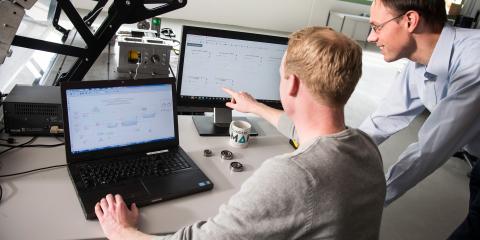Start guide for the most efficient condition monitoring solution

Introduction
The application of predictive maintenance can reduce maintenance costs considerably when implemented correctly. However, identifying the precise components of a machine or production-line to instrument with sensors in order to monitor the condition of the machine can be cumbersome, and the proper selection of the required sensors can be even more complex. For this reason, Flanders Make is working on a start-guide to support companies in their digitalization quest and implementation of condition monitoring systems. This start-guide will be focused on condition monitoring systems (hardware and software) for rotating machinery that are used in the manufacturing industry.
Rotating machinery
To avoid breakdown and the corresponding high costs, often time-based or preventive maintenance is performed at very conservative intervals. This reduces the risk of breakdown but increases both the labor costs of the maintenance team and the cost of the required replacement parts. Implementing condition monitoring systems can make the entire maintenance process more efficient by using more of the viable lifetime of components such as bearings and gears, and at the same time identify those components that require maintenance or replacements to prevent unplanned downtime.
Efficient condition monitoring
The correct choice of sensors, acquisition hardware, data processing algorithms, data storage and visualization contribute to the success of an efficient condition monitoring system. To this purpose, Flanders Make is in the progress of developing a start guide which companies can help guide them to the right condition monitoring solution for a certain maintenance problem, starting from the critical components to be monitored, and finishing by proposing the most efficient type of sensor.
Steps in the guided process:
- Identifying critical component of the rotating machinery
(supported by experience or a cost-benefit analysis)
- Identification of the type of problem with this specific component, during operation, or detected during maintenance or after disassembly
- Choosing the correct type of senor
- Setting up requirements list to be supplied to system or service provider
Challenges
It is impossible to develop the start-guide such that the proposed sensor is definitely the only and most efficient solution. The application of sensors in industrial cases will have specific boundary conditions and limitations, and therefore, the final step in the start guide is to try and identify these boundary conditions and corresponding requirements for the monitoring system. In this last stage, we will try to answer the following questions:
- Is a commercially available solution available?
- Which information is best shared with a potential supplier to offer an optimal solution?
- Does the machine run at varying operational conditions, making diagnosis complicated?
- Are the optimal mounting positions difficult to reach?
- Are there other difficulties for the specific case?
If the start guide gives no clear answer or these questions raise concerns concerning the feasibility of a monitoring solution, a more profound study might be required, where Flanders Make can assist with:
- A theoretical feasibility analysis
- Using the project demonstrator to gather data for a proof of concept
Demonstrator
In order to support companies with their complex monitoring problems, Flanders Make is also developing a specific data acquisition system with an easy-to-use dashboard, this project demonstrator will be used to showcase possible monitoring solutions for different sensors, data processing technologies, and visualization capabilities. This demonstrator can be applied in feasibility studies before companies buy their own condition monitoring system, or condition monitoring service from a supplier. When more complex problems come to light, this data acquisition system can be used to gather data, that could be used for development of case specific data analysis techniques and condition monitoring algorithms.